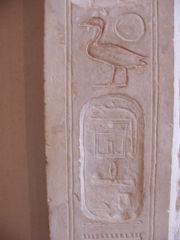
Sobekhotep III
Encyclopedia

Ancient Egypt
Ancient Egypt was an ancient civilization of Northeastern Africa, concentrated along the lower reaches of the Nile River in what is now the modern country of Egypt. Egyptian civilization coalesced around 3150 BC with the political unification of Upper and Lower Egypt under the first pharaoh...
king of the 13th dynasty
Thirteenth dynasty of Egypt
The thirteenth dynasty of ancient Egypt is often combined with Dynasties XI, XII and XIV under the group title Middle Kingdom. Other writers separate it from these dynasties and join it to Dynasties XIV through XVII as part of the Second Intermediate Period...
.
Family
The family of the king is known from several sources. A monument from Sehel IslandSehel Island
Sehel Island is located in the Nile, about 2 miles southwest of Aswan in Egypt. It is a large island, twice the size of Aswan's Elephantine Island, and is roughly halfway between there and the Aswan Low Dam . On Sehel Island, there are many inscriptions in the granite boulders...
shows Sobekhotep with his father Mentuhotep, his mother was Iuhetibu (Yauheyebu), his brothers Seneb and Khakau, and a half-sister called Reniseneb. Reniseneb was a daughter of Iuhetibu and her second husband Dedusobek.
Sobekhotep II had two wives, Senebhenas and Neni. A stela from Koptos (Qift), now in the Louvre
Louvre
The Musée du Louvre – in English, the Louvre Museum or simply the Louvre – is one of the world's largest museums, the most visited art museum in the world and a historic monument. A central landmark of Paris, it is located on the Right Bank of the Seine in the 1st arrondissement...
(C 8), mentions the daughters of Neni: Iuhetibu (Fendy) and Dedetanuq. Iuhetibu Fendy wrote her name in a cartouche
Cartouche
In Egyptian hieroglyphs, a cartouche is an ellipse with a horizontal line at one end, indicating that the text enclosed is a royal name, coming into use during the beginning of the Fourth Dynasty under Pharaoh Sneferu, replacing the earlier serekh...
. This is a second time in Egyptian history that a king's daughter received this honor.
Senebhenas is shown with Sobekhotep on an altar in Sehel Island
Sehel Island
Sehel Island is located in the Nile, about 2 miles southwest of Aswan in Egypt. It is a large island, twice the size of Aswan's Elephantine Island, and is roughly halfway between there and the Aswan Low Dam . On Sehel Island, there are many inscriptions in the granite boulders...
and a stela in Wadi el-Hol. The stela depicts Sobekhotep III before the god Monthu. He receives an ankh
Ankh
The ankh , also known as key of life, the key of the Nile or crux ansata, was the ancient Egyptian hieroglyphic character that read "eternal life", a triliteral sign for the consonants ʻ-n-ḫ...
and a was
Was
The was sceptre is a symbol that appeared often in relics, art and hieroglyphics associated with the ancient Egyptian religion...
-scepter from the god. Sobekhotep is followed by his father Montuhotep, his mother Iuhetibu, and his wife Senebhenas.
Reign
Sobekhotep III is known from a high number of objects despite the fact that the Turin King List gives him a reign of only four years and two to four months in length. He added inscriptions to the temple of MenthuMenthu
In Ancient Egyptian religion, Monthu was a falcon-god of war. Monthu's name, shown in Egyptian hieroglyphs to the right, is technically transcribed as mntw...
at Madamud
Medamud
Medamud was a settlement in Ancient Egypt. Its present-day territory is located about 8 km east-north from Luxor. The temple was excavated by Fernand Bisson de la Roque in 1925, who identified several structures dedicated to the war-god Monthu....
and built a chapel at El Kab
El Kab
El Kab is an Upper Egyptian site on the east bank of the Nile at the mouth of Wadi Hillal, about 80 km south of Luxor, consisting of prehistoric and Pharaonic settlements, rock-cut tombs of the early 18th Dynasty , remains of temples dating from the Early Dynastic period to the Ptolemaic...
. On Sehel was found an altar with his name.
A number of scarab seal
Scarab artifact
Scarabs were popular amulets in ancient Egypt. According to ancient Egyptian myths, the sun rolls across the sky each day and transforms bodies and souls. Modeled upon the Scarabaeidae family dung beetle, which rolls dung into a ball for the purposes of eating and laying eggs that are later...
s have been found that were from an officier of the ruler's table Sobekhotep begotten of the officier of the ruler's table Mentuhotep. It is possible that these seals belonged to Sobekhotep III before he became king.
Sobekhotep III was the first of a group of Thirteenth Dynasty kings about whom there exists historical records. This group of Thirteenth Dynasty kings are all known from a large number of objects. These kings produced many seals and there are many private monuments that can be dated to these reigns. This would seem to indicate that Egypt was relatively stable during this period.

